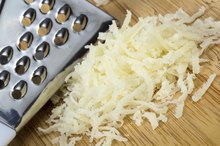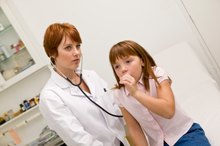Should a Toddler With Phlegm Drink Milk?
Toddlers can get colds and infections that cause coughing and congestion. A wet, or mucus-filled, cough can produce phlegm in toddlers. The University of Maryland Medical Center reports that there is no evidence that milk will worsen mucus in toddlers or anyone else 2. Consult your pediatrician for appropriate treatment if your toddler has phlegm.
If you are experiencing serious medical symptoms, seek emergency treatment immediately.
Phlegm and Colds
Phlegm refers to mucus that builds up in the throat. Children with phlegm often have to cough to expel the mucus. Phlegm is usually watery and can be various colors, depending on what's causing it. If your toddler has phlegm, her cough may sound rattling or like she has liquid in her throat. Other symptoms that may accompany phlegm coughs include mild fever, runny nose and sneezing, according to the website What to Expect 1. A toddler with phlegm likely has a cold or other viral infection.
- Phlegm refers to mucus that builds up in the throat.
- If your toddler has phlegm, her cough may sound rattling or like she has liquid in her throat.
Milk Theory
Drinking Milk & Honey as a Chest Decongestant
Learn More
Although some people believe that milk and other dairy products can cause your body to produce phlegm, research suggests that milk does not cause mucus. A review of the available evidence published in the “Journal of the American College of Nutrition” in 2005 found that milk consumption does not lead to the production of mucus. Researchers reported that people with the cold virus who drank milk did not have increased nasal secretions, cough or congestion.
Milk Allergy
An allergic reaction to milk is one of the most common food allergies in children 3. Many children outgrow a milk allergy by age three. The symptoms of milk allergy can vary from mild to severe. Toddlers with a milk allergy may develop hives or start wheezing or vomiting immediately after drinking milk. Other symptoms can include diarrhea, abdominal cramps, runny nose and watery eyes. A milk allergy may cause asthma-like symptoms in some people, but the occurrence is rare, reports the 2005 "Journal of the American College of Nutrition."
- An allergic reaction to milk is one of the most common food allergies in children 3.
- Toddlers with a milk allergy may develop hives or start wheezing or vomiting immediately after drinking milk.
Recommendations
What to Do for a 2 Year Old's Sinus Congestion
Learn More
Fluid replacement is important for toddlers with phlegm and a common cold. In particular, water can help to lubricate the mucus membrane, according to the University of Maryland Medical Center 2. Although toddlers cannot take most over-the-counter medications for phlegm, some home remedies can help. Chicken soup does help to ease congestion. A cool-mist humidifier can loosen up mucus and congestion. A spoonful of honey is also an effective treatment to help soothe the throat. Just remember that you can give honey only to children over the age of one.
- Fluid replacement is important for toddlers with phlegm and a common cold.
- Although toddlers cannot take most over-the-counter medications for phlegm, some home remedies can help.
Related Articles
References
- What to Expect: Caring for Toddler Coughs
- KidsHealth.org: Milk Allergies
- Lillehoj EP, Kato K, Lu W, Kim KC. Cellular and molecular biology of airway mucins. Int Rev Cell Mol Biol. 2013;303:139-202. doi:10.1016/B978-0-12-407697-6.00004-0
- Bills G, Rose C. Principles of Pharmacology for Respiratory Care. Sudbury, MA: Jones & Bartlett Learning; 2019.
- Fahy JV, Dickey BF. Airway mucus function and dysfunction. N Engl J Med. 2010;363(23):2233-47. doi:10.1056/NEJMra0910061
- Seaton A, Leitch G, Seaton D. Crofton and Douglas's Respiratory Diseases. Hoboken, NJ: Wiley; 2008.
- Scaglione F, Petrini O. Mucoactive agents in the therapy of upper respiratory airways infections: fair to describe them just as mucoactive?. Clin Med Insights Ear Nose Throat. 2019;12:1179550618821930. doi:10.1177/1179550618821930
- American Thoracic Society. (2015). What Are the Signs and Symptoms of COPD?
- Centers for Disease Control and Prevention. (n.d.). Runny Nose (with green or yellow mucus).
- Martínez-girón R, Mosquera-martínez J, Martínez-torre S. Black-Pigmented Sputum. J Cytol. 2013;30(4):274-5.
- Nadel, J.A. (2016). Airway Epithelium and Mucous Secretion. Murray and Nadel's Textbook of Respiratory Medicine. 6th ed. 10, 157-167.
- National Health Service. (2015). Coughing up blood (blood in phlegm).
- Rogers, D.F. (2014). Airway Mucus and the Mucociliary System. Middleton's Allergy: Principles and Practice. 47, 739-753
- Rubin, B.K. (2002). Physiology of Airway Mucus Clearance. Respir Care. 47(7), 761-8
- Barnes, P.J., Drazen, J.M., Rennard, S.I. & Thomson, N.C. (2002). Asthma and COPD: Basic Mechanisms and Clinical Management. Academic Press : Elsevier
Writer Bio
Ireland Wolfe has been writing professionally since 2009, contributing to Toonari Post, Africana Online and Winzer Insurance. She obtained her Bachelor of Arts in psychology and Master of Arts in mental health counseling. She is also a licensed mental health counselor, registered nutritionist and yoga teacher.









